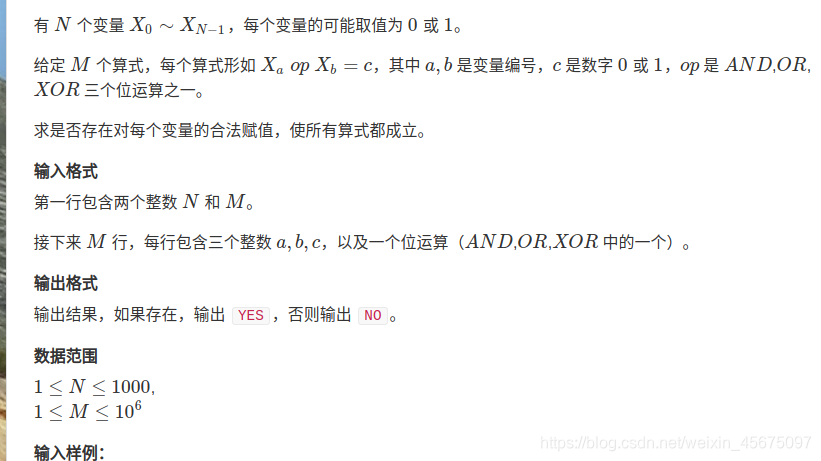Description
Katu Puzzle is presented as a directed graph G(V,E) with each edge e(a,b) labeled by a boolean operator op (one of AND, OR, XOR) and an integer c (0≤c≤1). One Katu is solvable if one can find each vertex Vi a value Xi (0≤Xi≤1) such that for each edge e(a,b) labeled by op and c, the following formula holds:
XaopXb=c
The calculating rules are:
Given a Katu Puzzle, your task is to determine whether it is solvable.
Input
The first line contains two integers N (1≤N≤1000) and M,(0≤M≤1,000,000) indicating the number of vertices and edges.
The following M lines contain three integers a (0≤a<N), b(0≤b<N), c and an operator op each, describing the edges.
Output
Output a line containing “YES” or “NO”.
Samples
Input 复制
4 4
0 1 1 AND
1 2 1 OR
3 2 0 AND
3 0 0 XOR
Output
YES
Hint
X0=1,X1=1,X2=0,X3=1

思路:
算是2-SAT的板子题,所以思路偏重于建图的过程。
连边x->y表示选择x必须选择y,那么分别考虑以下的情况。
| a | b | a and b |
|---|---|---|
| 0 | 0 | 0 |
| 0 | 1 | 0 |
| 1 | 0 | 0 |
| 1 | 1 | 1 |
所以当a and b = 0时:
-
若a=1,则必定满足b=0;
-
若b=1,则必定满足a=0;
当 a and b = 1时:
- a=1并且b=1;
| a | b | a or b |
|---|---|---|
| 0 | 0 | 0 |
| 0 | 1 | 1 |
| 1 | 0 | 1 |
| 1 | 1 | 1 |
所以当 a or b = 0 时:
- a=0并且b=0;
当a or b = 1时:
- 若a=0,则b=1;
- 若b=0,则a=1;
| a | b | a xor b |
|---|---|---|
| 0 | 0 | 0 |
| 0 | 1 | 1 |
| 1 | 0 | 1 |
| 1 | 1 | 0 |
所以当 a xor b = 0时:
-
若a=0,则b=0;
-
若b=0,则a=0;
-
若a=1,则b=1;
-
若b=1,则a=1;
当a xor b = 1时:
-
若a=0,则b=1;
-
若b=1,则a=0;
-
若a=1,则b=0;
-
若b=0,则a=1;
假设i表示该值取1,i+n表示该值取0。
按照以上列出的关系连边就可以。
这里有个要注意的点:当a=1并且b=1的时候如何连边?
这里的思路有点特殊:
add(a+n,a);add(b+n,b);
个人的理解是这样表示的含义是:
选择了a=0就必须选择a=1,所以只能选择a=1;
选择了b=0就必须选择b=1,所以只能选择b=1;
建图后跑一遍tarjan,如果发现i和i+n在同一个scc里,说明出现了矛盾。
如果所有的点都合法则输出YES。
#include<bits/stdc++.h>
using namespace std;
typedef long long ll;
typedef unsigned long long ull;
typedef pair<ll,ll>PLL;
typedef pair<int,int>PII;
typedef pair<double,double>PDD;
#define I_int ll
inline ll read()
{
ll x=0,f=1;
char ch=getchar();
while(ch<'0'||ch>'9')
{
if(ch=='-')f=-1;
ch=getchar();
}
while(ch>='0'&&ch<='9')
{
x=x*10+ch-'0';
ch=getchar();
}
return x*f;
}
#define read read()
#define closeSync ios::sync_with_stdio(0);cin.tie(0);cout.tie(0)
#define multiCase int T;cin>>T;for(int t=1;t<=T;t++)
#define rep(i,a,b) for(int i=(a);i<=(b);i++)
#define repp(i,a,b) for(int i=(a);i<(b);i++)
#define per(i,a,b) for(int i=(a);i>=(b);i--)
#define perr(i,a,b) for(int i=(a);i>(b);i--)
ll ksm(ll a,ll b,ll p)
{
ll res=1;
while(b)
{
if(b&1)res=res*a%p;
a=a*a%p;
b>>=1;
}
return res;
}
const int maxn=1100,inf=0x3f3f3f3f;
#define PI acos(-1)
const double eps=1e-4;
int n,m;
vector<int>g[maxn];
void add(int x,int y)
{
g[x].push_back(y);
}
int dfn[maxn],low[maxn],timetmp;
int id[maxn];
stack<int>stk;
bool instk[maxn];
int cnt=0;
void tarjan(int u)
{
dfn[u]=low[u]=++timetmp;
stk.push(u);
instk[u]=1;
for(int t:g[u])
{
if(!dfn[t])
{
tarjan(t);
low[u]=min(low[u],low[t]);
}
else if(instk[t]) low[u]=min(low[u],dfn[t]);
}
if(low[u]==dfn[u])
{
int y;
cnt ++ ;
do
{
y=stk.top();
stk.pop();
instk[y]=0;
id[y]=cnt;
}
while (y != u);
}
}
int main()
{
n=read,m=read;
while(m--)
{
char op[10];
int a=read,b=read,w=read;
cin>>op;
if(op[0]=='A')
{
if(w==0)
{
add(a,b+n);add(b,a+n);
}
else
{
/// ?add(a,1,b,1);
add(a+n,a);add(b+n,b);///a+n为0,a为1
}
}
else if(op[0]=='O')
{
if(w==0)
{
///add(a,0,b,0);
add(a,a+n);
add(b,b+n);
}
else
{///a+n为0,a为1
add(a+n,b);
add(b+n,a);
}
}
else if(op[0]=='X')
{
if(w==1)
{
add(a+n,b);
add(b,a+b);
add(a,b+n);
add(b+n,a);
}
else
{
add(a+n,b+n);
add(b+n,a+n);
add(a,b);
add(b,a);
}
}
}
for(int i=0; i<2*n; i++)
if(!dfn[i]) tarjan(i);
for(int i=0; i<n; i++)
if(id[i]==id[i+n])
{
puts("NO");
return 0;
}
puts("YES");
return 0;
}